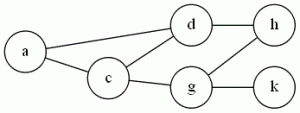This is jumping ahead a little, but this is a variant of 3SAT that will be helpful in the future (actually, for the next problem)
The problem: Not-All-Equal-3SAT (NAE3SAT). This is problem LO3 in the appendix.
The description: Just like 3SAT, except instead of requiring at least one of the literals in each clause to be true, we’re requiring at least one literal to be true and at least one literal to be false. So we’re removing the case where all three literals can be true.
Notice that if we have an assignment of variables that is a NAE3SAT solution, then if we negate all of the variables, we still have a NAE3SAT solution
The reduction: From regular 3SAT. We’re given a formula that is a collection of 3-literal clauses. For each clause (x1 ∨ x2 ∨ x3) we create a new variable ci (for clause i) and add 2 clauses to our NAE3SAT instance:
(x1∨ x2 ∨ ci) and (x3 ∨ ~ci ∨ F) (Where “F” is the constant value false. We’ll talk more about this later)
The idea is that ci is there to “fix” the clause. If the original clause was satisfiable because of x1 or x2, then ci can be false, and its negation can make the second clause true. If the original clause was satisfiable because of x3, we can make ci true. If the original clause had all three literals satisfiable, we can make ci false, and become an acceptable NAE3SAT solution.
Note that because the definition of NAE3SAT (and, for that matter, regular 3SAT) is defined in terms of collections of 3 variables, the constant value false we used above isn’t strictly legal. We’ve really just shown “NAE3SAT with some constants replacing variables” is NP-Hard. To show “normal” NAE3SAT is NP-Hard, we need to reduce the fixed constant version into the normal version:
Given an instance of NAE3SAT with fixed constants, we create 2 new variables xT and xF. We replace all instances of the constant value true with xT, and all instances of the constant value false with xF. We also add one additional clause:
(xT ∨ xT ∨ xF).
Note that this new clause is only NAESatisfiable if xT != xF. We can’t directly bind xT to true and xF to false because if you take a NAE3SAT solution and negate all literals, you get another NAE3SAT solution. But because of that, this is NAESatisfiable if and only if the original formula is.
Difficulty: It depends on what you give them. If you make them do everything I did above, I’d say it’s an 8. If you let them stop at the NAE3SAT with fixed constants, then maybe a 7.
